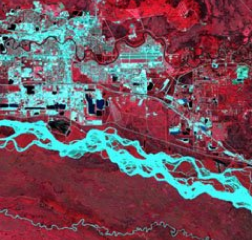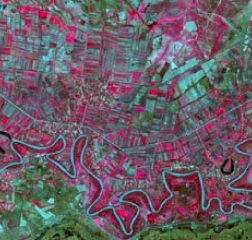Color Infrared Band Combination
Vegetation pops in red, with healthier vegetation being more vibrant in this band combination. It is easier to tell about different types of vegetation apart than it is with a natural color image. This is a very commonly used band combination in remote sensing when looking at vegetation, crops, and wetlands. In this band combination, it is displayed in R = XS3 (NIR band), G = XS2 (red band), and B = XS1 (green band). This rendition appears rather strange – vegetation jumps out as brighter because green vegetation readily reflects infrared light energy.
This band combination allows vegetation to be readily detected in the image. Vegetation emerges in shades of red, soils vary from dark to light browns and urban areas are cyan blue or at sometimes can appear yellow or grey, depending on their composition. Clouds, snow, and ice are light cyan or white. Hardwood trees will appear light red than Coniferous. Clearwater appears dark-bluish, while turbid water appears cyan.
Possibilities And Use Of Color Infrared Combination
Being one of the popular band combinations is useful for studying vegetation, drainage monitoring various stages of crop growth and soil patterns. In general, profound red hues show broadleaf or/and healthier vegetation whereas the lighter reds indicate sparsely vegetated or grasslands areas. Densely populated urban areas are indicated in light blue.
This band combination offers similar results to the traditional color infrared aerial photography. The spectral reflectance is based on water and chlorophyll absorption in the leaf. Needles have a dark response comparing to the leaves. There are various shades of vegetation due to type, health, leaf structure, and moisture content of the plant.
Different bands of a multispectral image can also be combined to bring out the vegetated areas. An example of the combination is the ratio of the NIR (near-infrared) band to the red band. The ratio is referred to as the RVI (Ratio Vegetation Index)

Since the vegetation has a high near-infrared (NIR) reflectance but a low red reflectance, the areas which are vegetated will have higher Ratio Vegetation Index (RVI) values as compared to the non-vegetated areas. Another usually used vegetation index is the NDVI (Normalized Difference Vegetation Index) that is computed by

This can also be combined with other bands to form a color composite images which can help in the perception of different types of vegetation.



